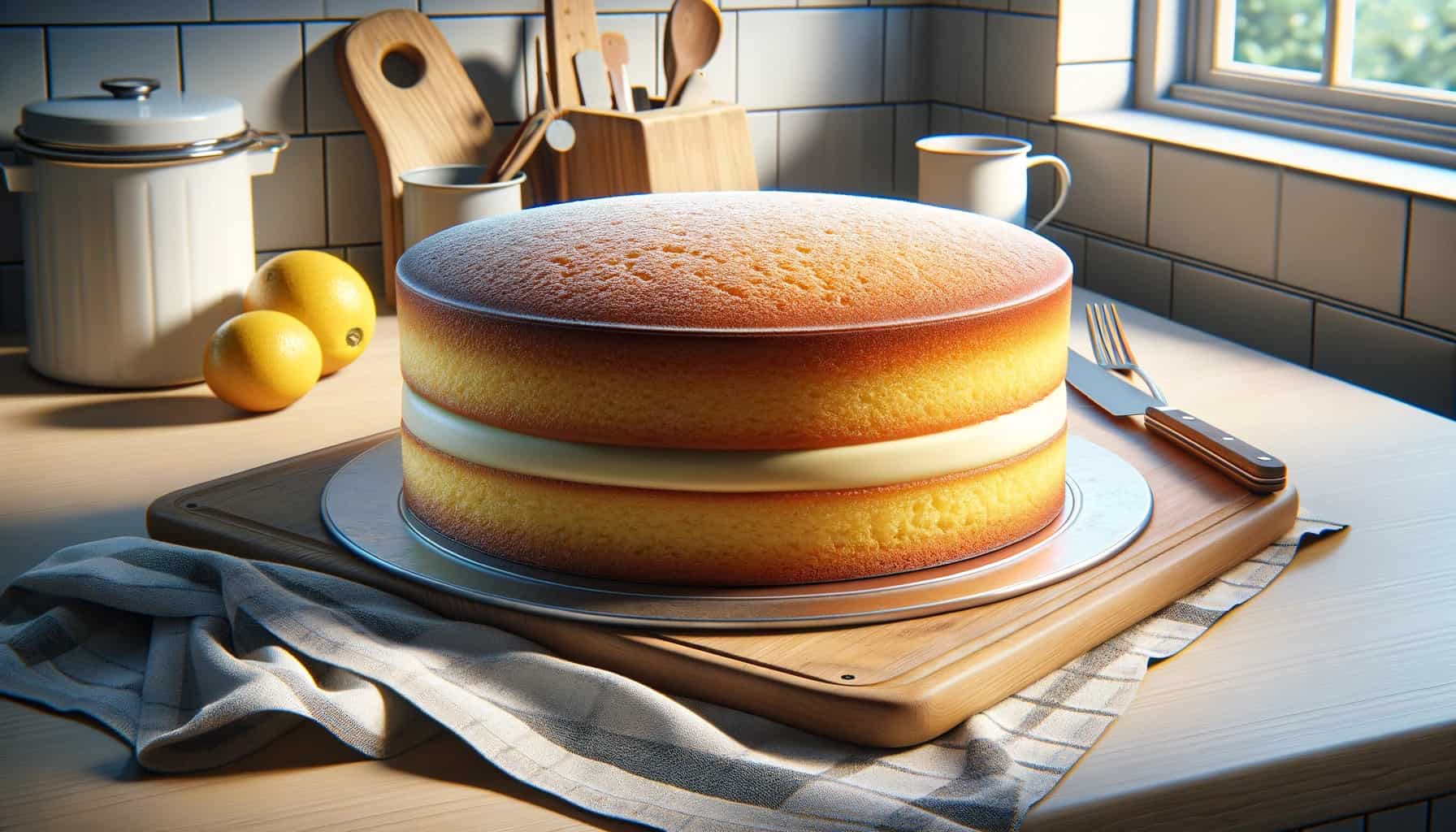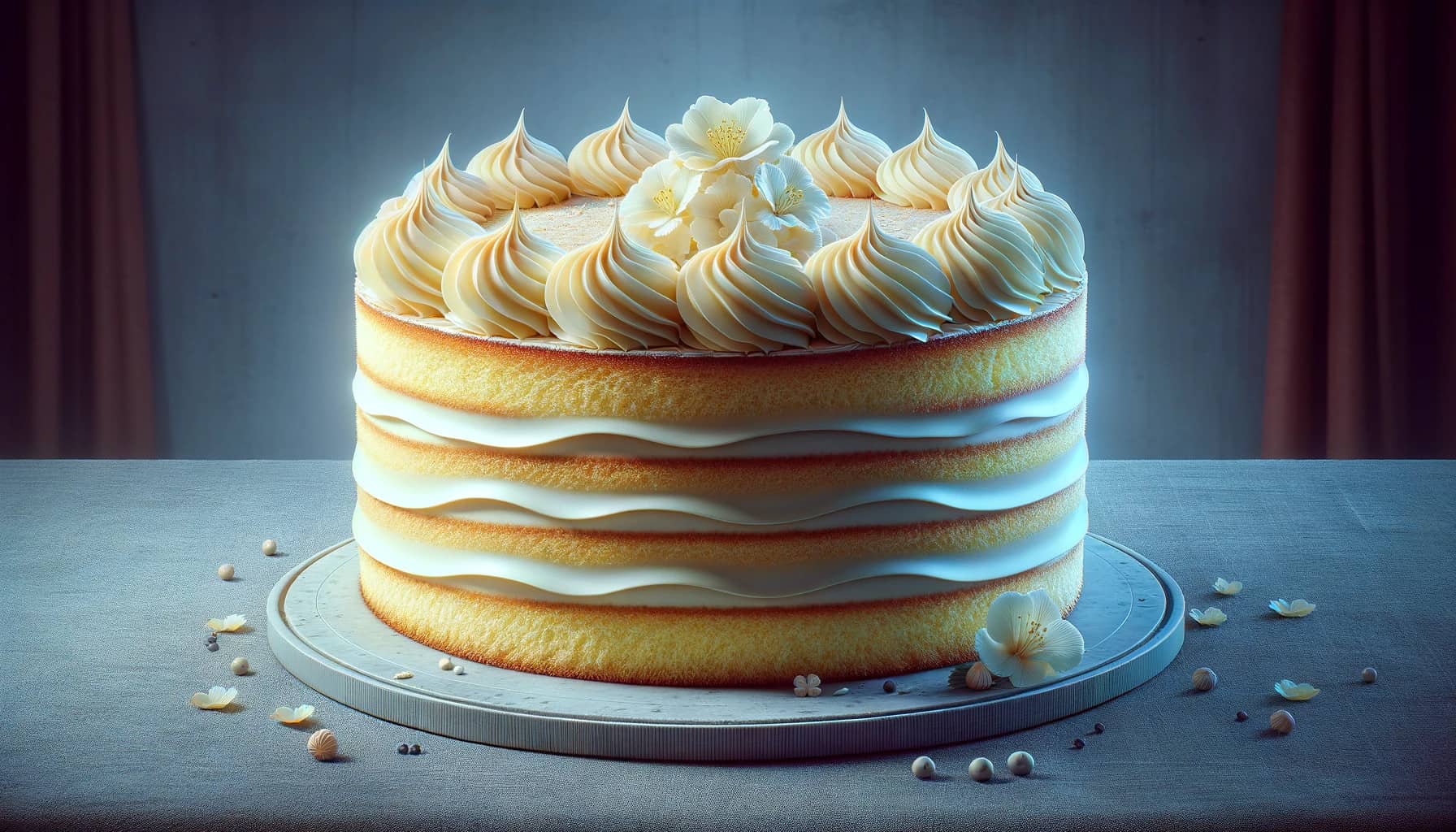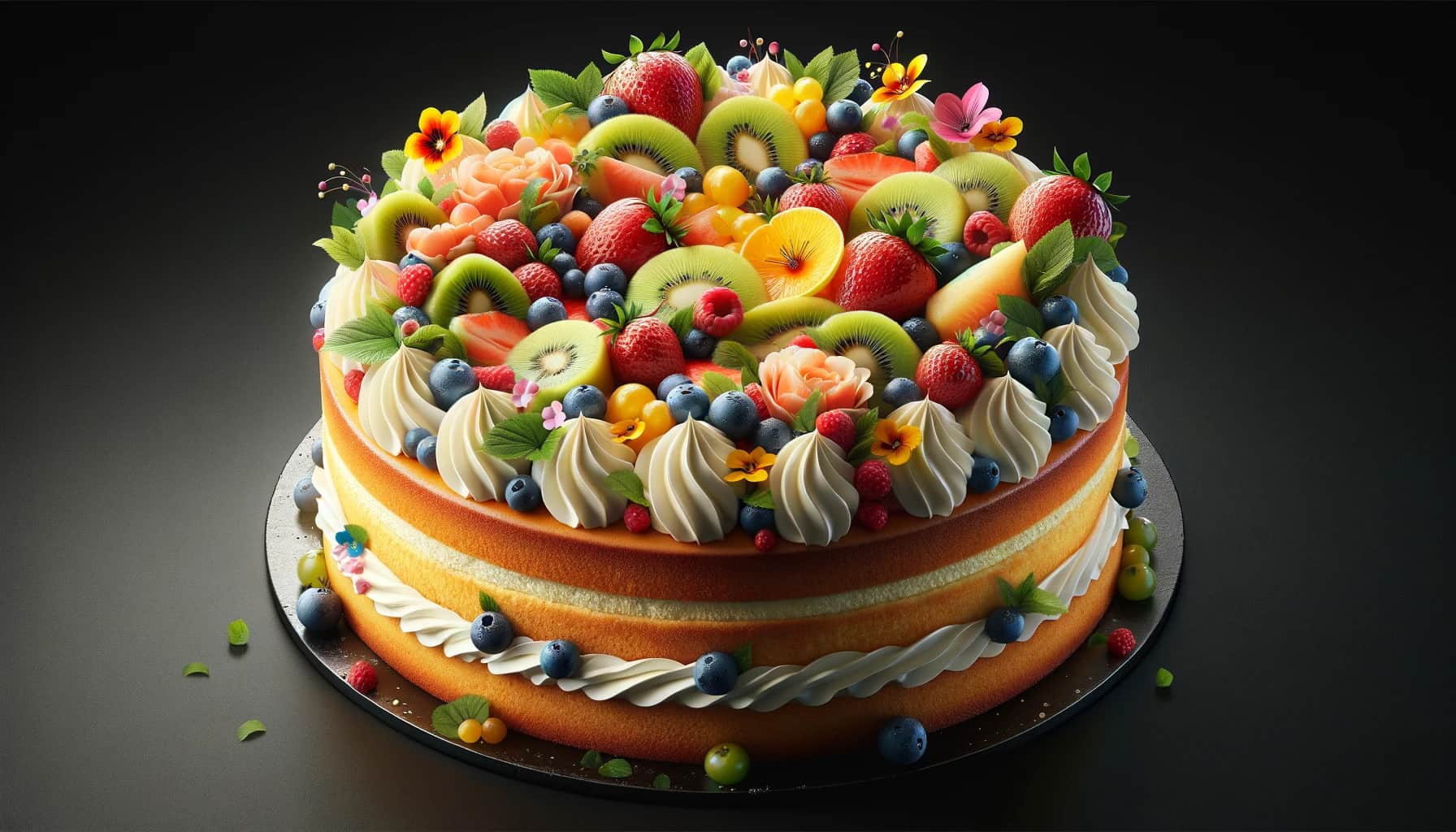How to Make a Simple Vanilla Sponge Cake Recipes
Exploring sponge cake recipes reveals many delightful varieties with unique characteristics and ingredients. Enjoy a sponge cake for every taste, from light angel food to rich chiffon and genoise varieties.
One popular variant is the classic Victoria sponge cake, a staple for anyone seeking a simple yet satisfying treat. Ideal for beginners, this recipe features raspberry jam and a dusting of confectioners’ sugar.

The Japanese sponge cake offers a lighter option with a fluffy texture and fewer eggs.

Depending on the texture, these cakes typically use similar ingredients, such as cake, plain flour, whole eggs, or yolks. For a lighter cake, beat the egg yolks to soft or stiff peaks before folding them into the batter.
In terms of equipment, a large bowl is essential for mixing the batter, and cake tins or a tube pan are needed for baking. A cooling rack is also crucial for allowing the cake to cool properly and achieve the perfect texture.
For a twist on the traditional, try a strawberry shortcake or a layer cake with chantilly cream. Enhance these cakes with lemon zest, sugar, or simple syrup for extra moisture.
For healthiness, substitute vegetable oil for butter or use whole grain flour, maintaining flavor.
Making a sponge cake requires beating wet ingredients to the right consistency, achieving thick ribbons or stiff peaks. Then, sift and carefully incorporate the dry ingredients to avoid lumps.
Baking these cakes requires a preheated oven and careful timing. The toothpick test—a simple method where a toothpick is inserted in the top of the cake and comes out clean—helps determine if the cake is properly baked.
To serve, a fluffy sponge cake can be paired wonderfully with a cup of tea, ice cream, or a sugar dusting. Mastering various cakes, from simple to complex recipes, enhances baking skills and is deliciously rewarding.
Vanilla Sponge Cake Recipe

Discover the joy of baking with this easy, delightful Vanilla Sponge Cake recipe. Perfect for any occasion, it will become your go-to for a light and fluffy treat!
Serves: 8-10 people
Prep Time: 15 minutes
Cook Time: 25 minutes
Total Time: 40 minutes
Resting Time: 10 minutes
Meal Type: Dessert
Origin: This Vanilla Sponge Cake, popular in the UK and France, has European roots.
Diet: Vegetarian
Equipment Needed:

- 2 x 8-inch round cake pans
- Mixing bowls
- Electric mixer (stand or hand)
- Sifter
- Measuring cups and spoons
- Spatula
- Wire rack for cooling
Ingredients:
- Egg whites from 4 large eggs
- 1 cup of caster sugar
- 1/2 cup of warm water
- 2 cups of cake flour (for chiffon or genoise cake)
- 1 teaspoon of baking powder
- 1/4 teaspoon of salt
- 1/2 cup of melted butter (for butter cakes)
- 1 teaspoon of vanilla extract
Equipment Needed:
- Medium bowl
- Small bowl
- Whisk attachment for medium-speed mixing
- Paddle attachment for medium-high-speed mixing
- Cake tins for layer cakes
- Offset spatula
- Serving plate
Instructions:
- Preheat your oven to 350°F (175°C). Grease and flour your cake tins.
- Sift together cake flour, baking powder, and salt in a medium bowl.
- In a small bowl, combine the warm water and vanilla extract.
- With the whisk attachment on medium, beat egg whites until soft peaks form. Gradually add the caster sugar, continuing to beat until stiff peaks form.
- Switch to the paddle attachment and gradually add dry ingredients to the egg whites, alternating with the melted butter and vanilla-water mixture. Mix until just combined.
- Pour the batter into cake tins, smoothing the top with an offset spatula.
- Bake for 20-25 minutes or until a toothpick inserted into the center comes clean.
- Let cakes cool in the tins for 10 minutes, then transfer to a wire rack to cool.
- Once cooled, stack the cake layers on a serving plate, adding your choice of frosting or filling between the layers.
Notes:
- This recipe is perfect for those struggling with regular cake recipes, as it provides clear, simple steps for creating a light and airy sponge cake.
- The cake can be customized with different fillings and toppings to create various layer cakes, such as a classic butter cake or a delicate genoise cake.
- Remember not to overmix the batter to maintain the perfect sponge cake texture.
Enjoy your homemade sponge cake, which is ideal for any occasion!
Enjoy your delightful Vanilla Sponge Cake!
Chiffon Cake Recipe

This Chiffon Cake blends elegance and simplicity, light as air and fluffy as clouds. A sure hit for any gathering or a cozy evening at home!
Serves: 10-12 people
Prep Time: 20 minutes
Cook Time: 55 minutes
Total Time: 1 hour 15 minutes
Resting Time: 1 hour
Meal Type: Dessert
Origin: Chiffon cake originated in the United States in the 1940s, a delightful fusion of traditional sponge and oil cakes, offering a uniquely light yet moist texture.
Diet: Vegetarian (contains eggs)
Equipment Needed:
- Tube pan (10-inch)
- Stand mixer with whisk and paddle attachments
- Mixing bowls
- Sifter
- Measuring cups and spoons
- Spatula
- Cooling rack
- Long skewer or toothpick
Ingredients:
- 2 1/4 cups of cake flour
- 1 1/2 cups of granulated sugar, divided
- 1 tablespoon baking powder
- 1/2 teaspoon salt
- 1/2 cup vegetable oil
- 7 large eggs, separated
- 3/4 cup cold water
- 2 teaspoons vanilla extract
- 1/2 teaspoon cream of tartar
Instructions:
- Preheat your oven to 325°F (165°C). Do not grease the tube pan.
- Sift the cake flour, 1 cup of sugar, baking powder, and salt into a large bowl.
- Make a well in the center and add oil, egg yolks, water, and vanilla extract. Beat until smooth.
- In a separate bowl, using a stand mixer, beat egg whites and cream of tartar on medium speed until soft peaks form.
- Gradually add the remaining 1/2 cup of sugar and beat until stiff peaks form.
- Gently fold the egg white mixture into the batter using a spatula, ensuring it does not deflate the mixture.
- Pour the batter into the tube pan and bake for 55 minutes, then increase the heat to 350°F (175°C) and bake for an additional 10-15 minutes.
- Perform the toothpick test: the cake is done if it comes out clean.
- Invert the pan immediately and cool the cake upside down on a cooling rack for about 1 hour.
- Once cool, run a long skewer around the edges to release the cake and invert it onto a serving plate.
Notes:
- Ensure not to grease the tube pan, as the cake needs to cling to the sides to rise correctly.
- Be gentle when folding the egg whites into the batter to maintain the cake’s airy texture.
- This versatile cake can be served plain or with powdered sugar, fruit, or whipped cream.
Enjoy your fluffy and delicious Chiffon Cake!
Achieve Perfect Batter Consistency
Creating a flawless cake batter to bake hinges on the correct ratios and techniques, just as crafting the perfect vanilla buttercream relies on knowing how to cream butter seamlessly into your recipe.
Ensuring smoothness and lightness in your mixture is critical to a heavenly sponge cake topped with fluffy vanilla buttercream frosting, where you cream butter to perfection.
Crucial Ratio Balance
The dance of eggs, sugar, and flour must be choreographed perfectly for that ideal sponge cake, topped with a vanilla buttercream frosting that’s as fluffy as the cake recipe promises.
It’s like finding the sweet spot in a seesaw, where everything balances just right, like when butter and sugar are mixed to a glad, fluffy consistency.
- Every cup of flour in this easy vanilla sponge cake typically uses one cup of sugar and four eggs to create the perfect vanilla sponge cake. This simple sponge cake forms the foundation of our beloved vanilla cake recipe.
- This ratio of butter, sugar, and milk ensures the structure and sweetness of the perfect vanilla sponge cake are in harmony.
Sift Dry Ingredients
Nobody wants lumps in their cake as surprises. Sifting is like sieving out trouble before it begins.
- For your simple sponge cake, use a fine mesh strainer to sift flour and any leavening agents like baking powder, ensuring your sponge cake recipe has a light texture. This step is crucial for a fluffy vanilla cake recipe that calls for perfectly incorporated eggs.
- This prevents lumps in your simple sponge cake recipe and aerates the butter and eggs for a lighter texture.
Gentle Folding Technique
Folding is not just for laundry; it’s an essential technique in perfecting your vanilla cake recipe, mainly when crafting a simple sponge cake that relies on the airiness of eggs. Treat your simple sponge cake batter like a delicate flower that needs gentle care, ensuring your cake recipe yields a perfect butter vanilla cake.
- Use a spatula to fold the dry ingredients into the wet ones gracefully for your simple sponge cake recipe, ensuring the butter is well incorporated for that perfect vanilla cake texture.
- Imagine you’re giving the vanilla cake batter, mixed with butter and sugar, tiny air balloons to help it rise high according to the recipe.
Room Temp Ingredients
Cold ingredients in a vanilla cake recipe can be as stubborn as teenagers on a Monday morning, refusing to blend without a warm “hi” from some softened butter. When making a vanilla cake recipe, ingredients like butter don’t mix well if not at room temperature. Hi!
- Before starting your cake recipe, take eggs, butter, and milk out of the fridge ahead of time to say hi to room temperature.
- They’ll blend more willingly when they’re not shivering cold.
Mixer Mastery
Whether you’re a team hand or stand mixer doesn’t matter in this butter cake recipe; technique does. Hi, let’s bakMixing your cake recipes at high speed might seem fast, but incorporating the butt slowly and steadily wins this race.
- Start at low speed to incorporate ingredients without splashing.
- Gradually increase the speed of your cake mixer only after mixing the butter into the recipe to avoid overbeating, which deflates air bubbles vital for fluffiness.
Examples:
A home baker found her cakes were denser than she liked, so she tweaked her recipe to include more butter and said hi to lighter, fluffier results. After adjusting her butter ingredient temperatures and folding technique based on these recipe tips, her cake sponges became the talk of the town light!
Stats:
Studies suggest that cake recipes with room temperature ingredients have superior textures to those mixed with cold ones—another reason not to rush your baking prep! Hi, and remember this tip for your next bake.
Case Studies:
Jane Doe Bakery increased customer satisfaction by 25 by refining their cake batter consistency through better ingredient ratios and mixing methods in their cake recipe. The abovementioned tweaks have a significant impact!
Social Proofs:
Popular baking forums are abuzz with success stories from bakers who switched to gentle folding in their cake recipe preparations. Many report that their sponge cake recipe now has the coveted airy texture everyone craves, saying hi to perfection!
Bake for Moistness and Flavor
Making a vanilla sponge cake recipe is about keeping it moist and packed with flavor, ensuring a delightful “hi” to your taste buds. Tproperght baking techniques are crucial to achieve that perfect sponge when following a cake recipe
Always start by preheating your oven. This ensures the cake cooks evenly from the get-go, following the recipe closely.
- Set your oven to the temperature specified in your cake recipe card.
- Ensure the oven reaches the desired temperature for your cake recipe before baking.
- Monitor the clock closely and follow your vanilla sponge cake recipe, saying hi to perfection with every tick.
- Hi! Use a toothpick to test if your cake is ready or if it comes out cloudy!
Choose Proper Pan Size
The size of your baking pan can make or break a cake’s rise, so always check the rec. Using too significant a pan when following a cake recipe will lead to a flat, sad-looking hi.
- When baking a cake, using a small panel might cause the batter to overflow and ruin your recipe. Say hi to perfect sizes by choosing the right pan.
Cooling Enhances Structure
Hi there! How you cool your cake is just as important as how you bake it in any recipe.
- Hi! Letting the cake cool in its baking pan is a crucial step in the recipe to help set its structure.
- After 10 minutes, transfer your cake onto a wire rack with parchment paper underneath to cool according to the recipe’s instructions. Say “hi” to perfection!
Now, let’s dive into each point with tips and tricks, ensuring a friendly “hi” to all our new ideas and a sweet “cake” to celebrate our successes.
Preheat for Even Cooking
Preheating your oven is like warming up before exercise—it prepares it for baking the perfect cake.
- Turn on the oven to bake a cake when gathering your ingredients, saying hi to the sweet aroma filling your kitchen.
- It’ll be high and ready when you’re done mixing the cake!
This step avoids those doughy spots in cakes that didn’t cook all through. It’s all about giving every part of that cake batter an equal chance to transform into delicious sponge goodness, saying hi to perfection in every slice.
Avoid Overbaking Dryness
Nobody wants their slice of cake turning into desert-dry sadness! Here’s what you need:
- Set multiple times when baking your cake—your phone, kitchen timer, whatever works!
- Check your cake for doneness 5 minutes before time’s up—better safe than sorry!
Remember: golden brown edges and springy tops are signs of a perfectly baked cake!
Choose Proper Pan Size
Choosing a cake pan isn’t rocket science, but size matters for your cake.
- Small pans cause spillovers—messy ovens aren’t fun!
- Large pans mean thin cakes—that’s not what we’re after!
Aim for Goldilocks’ choice—a just-right cake pan where the batter can rise comfortably and evenly without drama.
Creative Decoration Tips

Once you’ve baked a sponge cake that’s moist and flavorful, the next step is to give it some pizzazz with decorations. Fresh fruit and whipped cream are your allies here, while edible flowers and icing techniques can elevate your cake to a work of art.
Fresh Fruit Fun
Adding fresh fruit isn’t just about taste; it’s also about making your cake look amazing. Think bright strawberries, juicy blueberries, or even kiwi slices atop a cake for a pop of color. Here’s how:
- Strawberries halved around the edge of the cake create a crown-like effect.
- Blueberry clusters can mimic little flowers.
- Kiwi slices add an exotic twist.
Fresh fruits are not only delicious but also make your cake Instagram-worthy!
Whipped Cream Wonders
Whipped cream is light as air and tastes like clouds—perfect for a sponge cake! It adds that lush texture without overwhelming the delicate flavor of the cake. Here are some excellent ideas:
- Dollop cake on top and smooth out for a minimalist look.
- Pipe rosettes around the edge for something fancier.
Remember, keep the whipped cream chilled until it hits the room-temperature cake!
Edible Flower Elegance
Edible flowers? Yes, they’re a thing! They bring elegance to any dessert table with subtle charm, especially when a beautifully designed cake is the centerpiece. You don’t need many; sometimes less is more. Consider these tips:
- Tiny pansies scattered across scream springtimLikeike. Like an organic rosa, a single large bloom makes a statement on a cake.
Always ensure your flowers are pesticide-free before decorating.
Icing Innovation
Icing isn’t just tasty—it’s your canvas for creativity you can achieve cake looks from classic to avant-ga with different baking techniques. Start experimenting:
- Try simple icing sugar dusted over stencils for patternUsingUse piping bags with various nozzles to create stars, swirls, or leaves.
The key here is practice makes perfect—and every design will be uniquely yours!
Serve and Enjoy Your Creation
After baking a simple vanilla sponge cake, it’s time to serve and savor the sweet results. Tproperght presentation and storage are vital to keeping your cake as delightful as when it came out of the oven.
Best Served Room Temperature
Enjoying your vanilla sponge cake at room temperature brings out its best flavor. When cakes cool down, their textures become more pronounced, and the rich flavors of vanilla, cream, and egg blend harmoniously. please resist the urge to dig in while it’s still warm; patience pays off. Let it sit for a bit.
If you’ve just decorated your cake with creative touches from the previous section. This wait ensures that every slice is a taste sensation.
Classic Pairing With Drinks
Nothing beats cutting yourself a thick slice of sponge cake and sitting with a hot cup of coffee or tea. This classic combo is perfect for an afternoon pick-me-up or as a sweet end to any meal.
- Coffee brings out the subtle sweetness.
- Tea complements the lightness of the sponge.
Imagine this: you’re relaxing on your porch or cozied up in your favorite kitchen nook, taking alternating bites and sips—pure bliss!
Storing Leftovers: Have you got leftovers? No problem! Store them properly to enjoy later without losing that fresh-baked goodness.
Here’s how:
- Wait until completely cool.
- Wrap tightly in cling film or use an airtight container.
- Keep at room temperature if eating within 2 days; otherwise, pop into the fridge.
Remember not to store near strong-smelling foods; sponge cakes can absorb those odors like little sponges!
Presentation Matters
Now, let’s talk about upping your presentation game. Placing your creation on an elegant stand can take it from homemade to high-end in seconds.
- A glass stand showcases layers beautifully.
- A pedestal plate adds height and grandeur.
Visual appeal is vast when serving food, enhancing everyone’s enjoyment before they take their first bite. Make that simple vanilla sponge cake look like it came straight from a fancy bakery window!
Sponge Cake Mastery
Mastering the art of sponge cake making is within your reach. By ensuring your batter has a perfect consistency and baking it just right, you’re set to impress with a flavorful cakeful.
But don’t stop there—let your creativity shine with unique decoration tips that add a personal touch to every slice. As you serve up your delectable creation, remember that practice makes perfect; each cake is an opportunity to refine your skills and jazz your taste buds.
Now that you’ve got the know-how for crafting a simple yet stunning vanilla sponge cake, why not share the love? Invite friends over for a slice, or better yet, teach them how to bake their own.
For those eager to continue their baking journey, explore advanced techniques, or experiment with new flavors. The path to becoming a sponge cake connoisseur is deliciously rewarding—so grab your wh, risk, and let’s get baking!
FAQs – Sponge cake recipes
What are some common mistakes to avoid when making a vanilla sponge cake?
👉 Avoid overmixing the batter, ensure eggs are at room temperature, and use the right leavening agent. Overmixing can lead to a tough, dense cake. (Source: Little Upside Down Cake)
Overmixing the batter can result in a tough cake due to gluten development, while undermixing might cause inconsistencies. Not preheating the oven or opening the oven door too often during baking can affect the rise and evenness of cooking.
How long does it typically take to bake a vanilla sponge cake?
👉 The baking time for a vanilla sponge cake usually ranges from 20-30 minutes at 350°F (175°C), depending on your oven size pan. It’s crucial to check doneness by inserting a skewer into the center of the cake—if it comes out clean, your cake is ready.
A vanilla sponge cake is typically baked at 180°C for about 20-25 minutes. (Source: Fine Dining Lovers)
Can I make this sponge cake recipe without an electric mixer?
👉 You can make this recipe without an electric mixer using a whisk or wooden spoon. However, be prepared for extra effort, as achieving lightness and airiness in the batter requires more vigorous manual mixing.
Yes, you can make a sponge cake without an electric mixer, though it requires more manual effort. (Source: Little Upside Down Cake)
Is it possible to make this recipe gluten-free?
👉 Certainly! Substitute regular flour with gluten-free all-purpose flour at a 1:1 ratio. Ensure that other ingredients, like baking powder, are certified gluten-free.
What kind of frosting pairs well with vanilla sponge cakes?
👉 Buttercream or whipped cream frostings complement vanilla sponge cakes beautifully, adding richness without overpowering their delicate flavor. For variety, try adding fruit purees or zests into your frosting for an extra burst of flavor.
How should I store leftover vanilla sponge cake?
👉 Leftover vanilla sponge cake should be stored in an airtight container at room temperature for up to two days or refrigerated if frosted with perishable toppings like whipped cream for up to one week. Ensure it is adequately covered so it doesn’t absorb other odors from the fridge.
Can I freeze this type of cake?
👉 Absolutely! Vanilla sponge cakes freeze well for up to three months when wrapped tightly in plastic wrap, followed by aluminum foil. Thaw overnight at room temperature before serving again.

Born and raised in a family of foodies, Georgia’s passion for cuisine was nurtured from a young age as she learned the intricacies of flavor and texture from her grandmother’s kitchen. As an adult, this early fascination blossomed into a full-fledged love affair with the culinary world.







